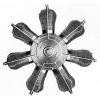



Selected Early Engines
Oberursel, Oerlikon, Opel, Orlo, Otto
Compiled by Kimble D. McCutcheon
Published 24 Jan 2023; Revised 25 Jan 2023
Oberursel
 |
 |
 |
 |
| Gnome | Le Rhône | ||
| Omega (AEE) | Omega-Omega (AEE) | Type 9J (NARA) | |
The Oberursel Motoren Gesellschaft of Frankfurt, Germany was licensed by Gnome in 1908 to build air-cooled rotary engines based upon the Gnome principle. In 1913, Oberursel was granted a license to build Le Rhone designs.
The Gnome-style cylinders with integral cooling fins were machined from solid steel billets. The articulated connecting rods employed a master rod supported on the crankshaft by two ball bearings. The in-piston inlet valves operated automatically, and the exhaust valves in the cylinder heads were operated by push rods and rockers. The carburetor was attached directly to the fixed hollow crankshaft, which also carried oil tubes fed by a plunger pump.
The U.0, a 7-cylinder licensed Gnome Lamda, with its 124 mm (4.882") bore, 140 mm (5.512") stroke and 11.835 l (722.20 in³), was rated 80 hp.
The U.I, a 9-cylinder licensed Gnome Delta, with a 124 mm (4.882") bore, 150 mm (5.906") stroke and 16.303 l (994.87 in³) displacement, was rated 100 hp.
The U.III, a 14-cylinder licensed Lamda-Lamda, displaced 23.670 l (1,444.40 in³) and was rated 160 hp.
The Ur.II, a 9-cylinder licensed Le Rhône Type 9J, had a 112 mm (4.409") bore, 170 mm (6.693") stroke, 15.074 l (919.87 in³) displacement and was rated 110 hp at 1,200 rpm.
The Ur.III, an 11-cylinder Ur.II development, displaced 18.423 l (1,124.26 in³) and produced 145 hp.
An 18-cylinder double-rotary with a 124 mm (4.409") bore, 150 mm (5.906") bore and, displaced 32.606 l (1,989.74 in³) and was rated 200 hp.
Oberursel experimented with a water-cooled geared V-8 rated 240 hp at 2,200 rpm and weighing 259.9 kg (573 lb).
Oerlikon
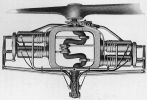 |
| Oerlikon (A39) |
The water-cooled horizontally-opposed 4-cylinder Oerlikon engine was constructed in the Swiss Machine Factory at Oerlikon, near Zurich, Switzerland. With a 100 mm (3.937") bore, 200 mm (7.874") stroke and 6.283 l (383.41 in³) displacement, it was rated 50 ‑ 60 hp at 1,000 – 1,200 rpm and weighed 79.83 kg (176 lb).
The cylinders were arranged in pairs but were constructed separately from nickel steel, and surrounded by corrugated sheet-copper water jackets. Concentric valves, placed co-axially in the cylinder heads, were operated by long push rods and rocker arms from a two-row cam. Auxiliary ports vented exhaust near the expansion stroke end. Cooling water entered the jackets from underneath and left through connections on top. A magneto supplied two spark plugs located diametrically opposite in each cylinder. A carburetor was attached to each cylinder pair's heads.
A stout open frame replaced the traditional crankcase, decreasing weight and improving piston and lower cylinder cooling. However, the open crankcase afforded no protection from dirt and made lubrication more difficult. The three-throw crankshaft was forged from round nickel steel bar stock. Two opposite connecting rods acted upon the center crankpin, which was wider than the end ones. The crankshaft and both connecting rod ends were fittesd will ball hearings.
Opel
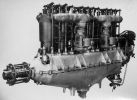 |
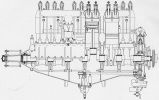 |
|
| Opel Type III (A39) | ||
The Adam Opel Motor Works of Russelsheim, Germany initially built the Type III 180 hp Argus design. Opel later designed an experimental air-cooled geared 9-cylinder (3 rows of 3) that produced 200 hp. This design was abandoned in favor of the BMW III-a engine.
The Type III was a water-cooled vertical six with a 145 mm (5.709") bore, 160 mm (6.299") stroke, 15.852 l (967.38 in³) displacement and 4.5:1 compression ratio. It was rated 180 hp at 1,400 rpm and 190 hp at 1,600 rpm. Fuel and oil consumption was 0.542 land 0.018 lb/hp/hr. It weighed 342.92 kg (756 lb).
The cylinders were made in pairs from steel forgings that were welded together at the flange, and encased by a common water jacket. They were offset from the crankshaft center line by 18 mm (0.709"). Inlet and exhaust valves with 66 mm (2.598") clear diameters and 45° seats, operated in the cylinder head via push rods and rockers from a spur-gear-driven camshaft. The inlet valve lift was 11.35 mm (0.447"), and the exhaust valve lift was 11 mm (0.433"). The inlet opened 12° early and closed 80° late; the exhaust opened 66° early and closed 13° late. The six-throw crankshaft ran on seven plain bearings and its crank-cheek cross sections progressively increased toward the propeller end. The H-section connecting rods had two-bolt caps and offset big ends to evenly space the crankshaft bearings between two cylinders located close together. The pistons were made from aluminum alloy and fitted with three rings.
Two German-built Zenith carburetors, having 39-mm venturis, 305-cc main jets, and 505-cc compensating jets, supplied the mixture. A multi-plunger pump provided lubrication. A centrifugal 24-gpm pump circulated cooling water and two Bosch Z-H-6 magnetos provided dual ignition.
 |
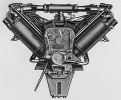 |
| Orlo B-8 (A39) | |
Orlo
The Orlo Motor Company of Rochester, New York built three water-cooled engine designs during 1916.
The Model B-4 was an inline-four with a 4.500" (114.3 mm) bore, 6.000" (152.4 mm) stroke and 381.70 in³ (6.255 l) displacement rated 50 hp at 1,300 rpm and weighing 220 lb (99.79 kg). The cylinders were cast separately and employed overhead valves. Dual ignition was provided, and a Schebler carburetor furnished the mixture.
The Model B-6 was an inline-six with cylinders identical to the B-4, resulting in a 572.56 in³ (9.38 l) displacement. It was rated 75 hp at 1,300 rpm and weighed 270 lb (122.47 kg).
The Model B-8 was a 90° V-8 using B-4 and B-6 cylinders that displaced 763.41 in³ (12.51 l). It was rated 100 hp at 1,300 rpm, 125 hp at 1,400 rpm, and weighed 480 lb (217.72 kg). A Zenith carburetor supplied the mixture, and two Dixie magnetos furnished dual ignition.
Otto
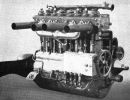 |
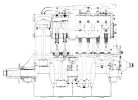 |
 |
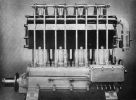 |
| A.G.O. 50 | A.G.O. 100 | ||
| (Wiki) | |||
Aeromotors Gustav Otto (A.G.O.) engines, designed by engineer Hans Geisenhof, were vertical water-cooled types with separately cast and machined L-head cylinders grouped into a single block by flanges and bolts passing through the water jackets fore-to-aft. Lubrication was by an eccentric oil pump, and ignition by a Bosch magneto.
The A.G.O. 50, an inline four designed in 1911 with a 110 mm (4.331") bore, 150 mm (5.906") stroke, and 5.702 l (347.96 in³) displacement, produced 50 hp. The spark plugs were located in plugs directly over the inlet valves. The connecting rods had H-section shanks and the crankshaft was carried in three plain bearings. On each side of the front main hearing was a radial hall hearing for the propeller thrust loads.
The A.G.O. 70, an inline six with cylinders identical to the A.G.O. 50, displaced 8.553 l (522.0 in³) and was rated 70 hp. The six-cylinder model, employing the same cylinders, had a displacement of 522.18 in³ and was rated 70 hp.
Otto built four- and six-cylinder vertical overhead-valve engines with 140 mm (5.512") bores and 150 mm (5.906") strokes. The inline four displaced 9.236 l (563.63 in³) and was rated 80 – 100 hp. The inline six displaced 13.854 l (845.45 in³) and was rated 100 – 130 hp.
The Otto works also produced a straight-eight that was rated 200 hp.
References
Angle, Glenn D, ed. Aerosphere 1939 (New York, New York: Aircraft Publications, 1940).
Anble, Glenn D, ed. Airplane Engine Encyclopedia (Dayton, Ohio: Otterbein Press, 1921).
Image Sources: A39 = Aerosphere 1939; AEE = Airplane Engine Encyclopedia; Flt = Flight Magazine; NARA = U.S. National Archives and Records Administration; UKNA = United Kingdom National Archives.